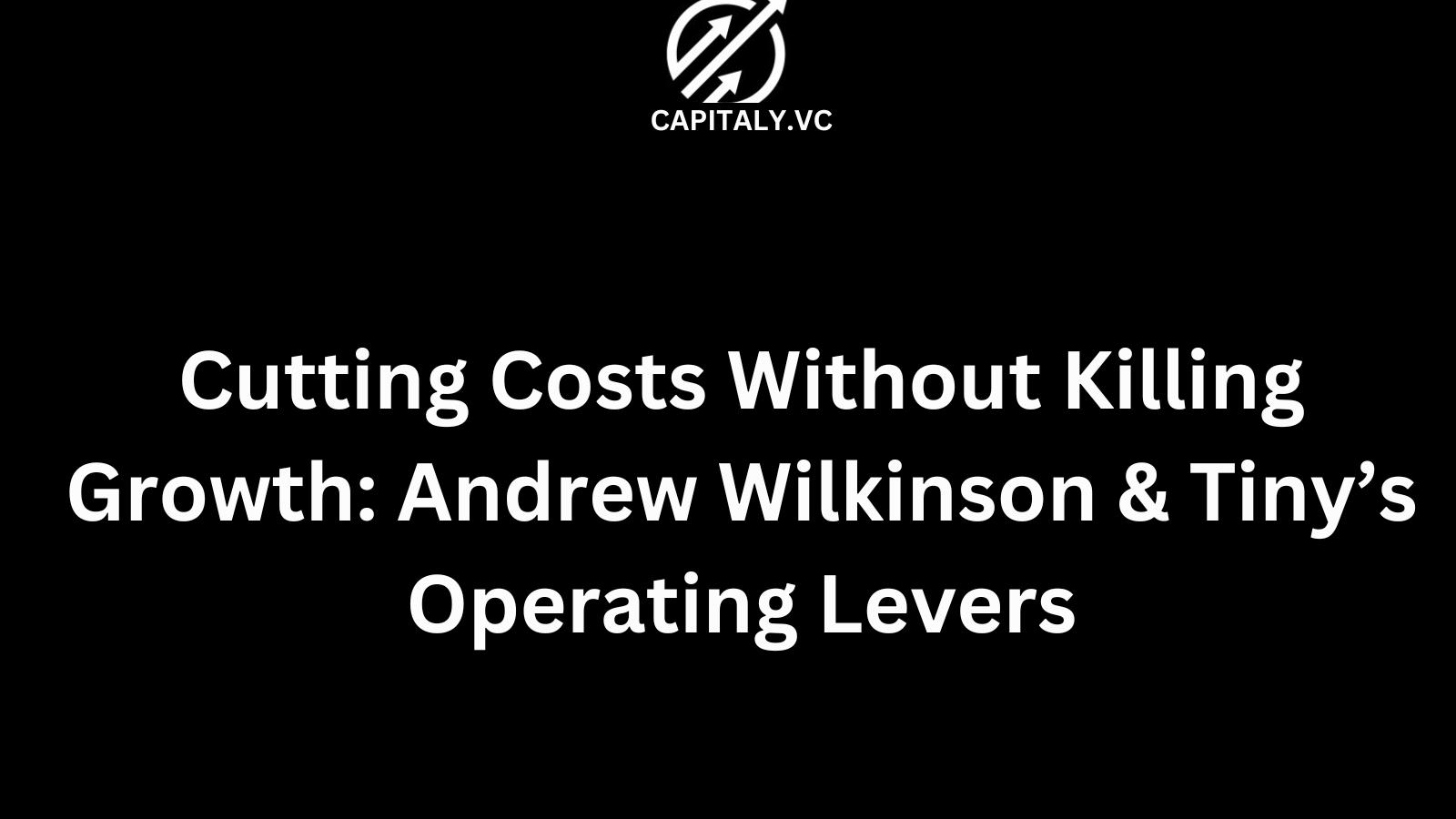Cutting Costs Without Killing Growth: Andrew Wilkinson & Tiny’s Operating Levers
Cutting Costs Without Killing Growth: Andrew Wilkinson & Tiny’s Operating Levers

Cutting Costs Without Killing Growth: Andrew Wilkinson & Tiny’s Operating Levers is my plain-English playbook for lowering burn and lifting margins without kneecapping the business.
I’ll show you the exact levers I pull, the order I pull them in, and the scripts I use to renegotiate, repackage, and remove waste.
I’ll write in the first person, keep every sentence short, and add examples you can copy today.
I’ll link related posts for deeper context so you can move fast.

1) Start With Cash, Not Slides
I bridge EBITDA to unlevered free cash flow and calculate burn multiple.
If EBITDA → FCF is leaky, I fix working capital before I touch headcount.
I set a 90-day cash goal and a weekly cadence.
For ruthless brevity while you run the sprint, see our blog post: I Don’t Respond to Long Emails.
2) Protect The Engines, Trim The Exhaust
I list the top 3 growth levers that make next quarter’s revenue.
I freeze cosmetic projects that don’t move CM, payback, or retention.
I keep budget on what compounds and starve what entertains.
3) Pricing Beats Penny-Pinching
I raise price or re-tier before I cut muscle.
I anchor to outcomes, not competitors.
If NRR stays ≥100% post-increase, I just grew margin with one email.
For value-based pricing scripts, see: Pricing Strategy That Works.
4) Contribution Margin Rescue
I rebuild CM = Revenue − variable costs from raw tables.
I include payment fees, shipping, packaging, support, refunds, and chargebacks.
I kill negative-margin SKUs and discount habits that hide the leak.
5) Vendor Renegotiation, Line-By-Line
I export the top 25 vendors by annualized spend.
I ask for term for price, prepay for discount, or volume for perks.
I bring one comparable quote and a calm deadline.
Email script (copy/paste).
“Hey {Name} — we value the partnership and need to reduce {X}% this term.
We can trade {longer term/prepay} for {price} and sign by {date}.
Can you confirm.”
6) Cloud & SaaS: FinOps In Two Weeks
I right-size instances, turn on autoscaling, and cut idle/over-provisioned resources.
I downgrade unused seats and consolidate duplicative tools.
I add budgets + alerts so surprises stop happening.
7) Paid Acquisition: Throttle By Payback
I pause channels with payback >12 months or blended CAC rising.
I double down where incremental CAC < CM in 90 days.
I favor owned channels (email/SMS/SEO) over rented ones.
8) Sales Comp That Pays For Itself
I align comp to gross profit, not topline.
I add ramp floors for new reps and remove draws that never end.
I pay accelerators on collectable revenue, not bookings theater.
9) Headcount: Freeze, Then Reshape
I start with a freeze and backfill veto for 30 days.
I eliminate roles that don’t touch the customer or the cash cycle.
I swap external contractors for cross-trained internal bench where quality allows.
10) Process & Automation: 30-Day “Stop Doing” List
I list the 10 recurring tasks with the highest hours × error cost.
I automate with native tools, simple scripts, or AI before I shop new software.
I delete reports nobody reads and approval steps nobody owns.
For a weekly execution rhythm, see: 02: Journaling With AI.
11) Working Capital: Quiet Dollars, Fast
I model DSO, DPO, DIO and build a 12-month NWC average.
I improve collections, negotiate supplier terms, and fix inventory truth.
I lock a clean peg so savings don’t vaporize at closing.
For the one-page peg primer, see: Working Capital Peg Explained.
12) Inventory & Logistics (Brands)
I value at lower of cost or NRV and set an obsolescence reserve.
I renegotiate 3PL SLAs, lanes, and cartonization to cut DIM weight.
I prune long-tail SKUs so turns rise and returns fall.
13) Support & Success Efficiency
I deflect common contacts with help docs + in-product tips.
I route high-value accounts to proactive success that prevents tickets.
I measure time-to-first-response and first-contact resolution like a hawk.
14) Kill Zombie Features And Pet Projects
I audit feature usage and cut what <5% of actives touch.
I say “no” to roadmap maybes until CM and payback stabilize.
I ship one hard thing that truly moves retention or AOV.
15) Security, Quality, And Incidents (Cheap Wins)
I implement SSO, least-privilege access, backups, RTO/RPO, and a real incident log.
I prevent expensive fires with boring hygiene.
I publish on-call rules so escalation doesn’t cost the weekend and the wallet.
16) Contract Cleanup & Risk
I collect change-of-control, MFN, and auto-renew landmines into one list.
I templatize MSA terms to stop bespoke lawyering.
I push shorter survival periods and a modest escrow in new deals.
17) Seasonality: Plan The Trough, Pre-Fund The Peak
I weight same-month YoY data and stage spend to meet the curve.
I build safety stock and cash buffers without starving Q1/Q2.
I don’t punish a Q4 brand for having Q4 inventory.
18) Marketplaces: Liquidity Over Coupons
I measure time-to-match, fill rate, and repeat by pocket.
I replace coupons with escrow, insurance, and better matching.
I price take rate on value delivered, not hopes.
For a deeper cut, read: Marketplace Exits: Network Effects and Liquidity.
19) Communication Hygiene That Halves Costs
I move to one thread, one weekly summary, and numbered asks.
I kill meetings that don’t ship decisions.
I write like a human so work moves.
For tone and speed, read: I Committed Email Suicide.
20) The 30-60-90 Cost Sprint
Days 1–30: Freeze hires, renegotiate top 25 vendors, throttle paid by payback, publish CM and peg.
Days 31–60: Ship pricing/packaging changes, automate top 10 tasks, prune SKUs/features.
Days 61–90: Lock new comp plans, codify SOPs, and restore selective growth spend that clears the bar.
For taste in capital allocation, skim: A $3,600 Keyboard and a $66 Million Dollar Investment.
Copy-Paste Playbooks & Scripts
Negotiation opener.
“We can extend term or prepay for {X%} relief and sign by {date}.
Can you meet us there.”
Paid throttle rule.
“If incremental CAC > CM at 90 days, pause and reallocate to owned channels.”
Freeze email to managers.
“30-day backfill freeze.
Exceptions require payback <6 months and written owner.
Weekly status Friday 2pm.”
Feature/sku removal note.
“We’re retiring {X} on {date} to focus on {Y} that 90% use.
If you depend on {X}, reply and we’ll migrate you.”
Internal Links For Deeper Context
For crisp, short emails that speed everything, see our blog post: I Don’t Respond to Long Emails.
For a weekly operating rhythm that compounds, read: 02: Journaling With AI.
For clear, memorable messaging during change, read: Never Tell, Always Storytell.
For capital allocation taste and simplicity, see: A $3,600 Keyboard and a $66 Million Dollar Investment.
FAQs
How do I know I’m cutting fat, not muscle.
I protect channels with payback <12 months, features tied to retention, and roles that touch the cash cycle.
What metric tells me if cuts are working.
Watch burn multiple, CM, and NRR weekly for 4–6 weeks.
Trends beat one-off wins.
Should I cut price to grow.
Rarely.
I prefer value-based pricing, packaging, and fences over discounting.
Where do cloud savings hide.
Idle resources, zombie projects, oversized instances, and unused SaaS seats.
Turn on alerts and rightsizing.
How fast can I renegotiate vendors.
Two weeks for the top 10 if you offer term, prepay, or volume trades and set a deadline.
What if my team morale dips.
Over-communicate decisions in one page and show the score weekly.
Calm beats spin.
Can I grow while in a freeze.
Yes.
Focus on owned channels, price power, and retention lifts that don’t require headcount.
Do I need a QoE to start.
No.
You need a cash→accrual bridge, CM truth, and a clean working-capital schedule.
How do I handle marketplace subsidies.
Replace coupon burn with trust add-ons (escrow, insurance) and better matching.
Track CM/transaction.
What if I cut and revenue dips.
Restore spend only where incremental CAC < 90-day CM and the engine restarts predictably.
How big should my vendor list be to attack.
Start with the top 25 by annualized spend.
Wins there pay for the whole sprint.
What’s the fastest single lever.
A clean pricing & packaging pass tied to value, not cost, usually moves the needle first.
Conclusion
Cutting Costs Without Killing Growth: Andrew Wilkinson & Tiny’s Operating Levers is about sequencing smart cuts, fixing contribution margin, cleaning working capital, and using value-based pricing so growth survives and margins expand.
Run the 30-60-90 sprint, keep one crisp thread, and trade noise for cash without sacrificing momentum.
Get Your Copy of Never Enough at https://www.neverenough.com/



.png)